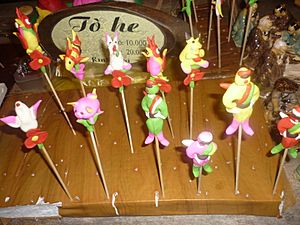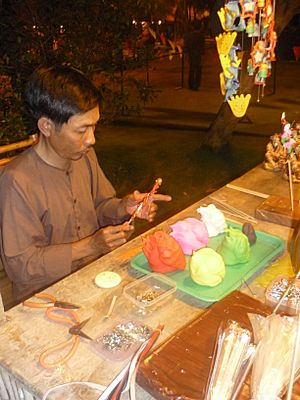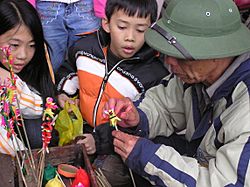Tò he facts for kids
Tò he is a special traditional toy from Vietnam. It's a small, edible figurine made from a dough of rice powder. These fun toys often look like animals, beautiful flowers, or famous characters from old folk stories. Imagine eating your toy after playing with it!
Long ago, Tò he was mostly sold during big celebrations like Tết (Vietnamese New Year) and the Trung Thu. These festivals are super popular with Vietnamese kids! Today, you can find Tò he at many traditional festivals and in public places like parks. Tò he is one of the few traditional toys still around in Vietnam. Because of this, making Tò he is seen as an important part of Vietnamese culture. People are working hard to keep this amazing art alive!
How Tò he is Made
To make a Tò he figurine, an artist needs a special dough. This dough is a mix of sticky (glutinous) and regular rice powder. This makes it easy to shape and safe for kids to eat. Artists also use thin bamboo sticks to hold the finished figurines. Of course, they also need their amazing skill to create the shapes!
What Tò he Looks Like
Tò he figurines are shaped by hand. They can be animals, flowers, or characters from popular folk tales. For example, you might see Tôn Ngộ Không, the Monkey King from the story Journey to the West. There are seven main colors for Tò he: green, sea blue, red, purple, yellow, white, and black. These colors come from mixing the rice powder with safe food dyes. In the past, colors came from plants or ashes, but food dyes are used now to make sure the toys are always safe to eat.
The Making Process
In the past, Tò he was steamed after being shaped. But now, artists use dough that's already cooked. This helps them make the figurines much faster! The dough is made by mixing glutinous and regular rice powders with fresh water. This mix is then boiled for about an hour. After it's cooked, the dough is dyed with different food colors.
The Art of Tò he Making
Making Tò he needs a lot of patience from the artist. Most Tò he makers are men. For a long time, the special secrets of making Tò he were only passed down from fathers to their sons or daughters-in-law. Daughters usually didn't learn the craft. Sons would learn just by watching their fathers and practicing on their own. There weren't any formal classes.
However, things are changing! Today, Tò he making is also taught to people with disabilities. This helps them learn a valuable skill and make a living by creating Tò he and other traditional art forms. It's a wonderful way to keep this unique Vietnamese tradition alive and help more people become part of it.




